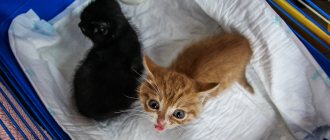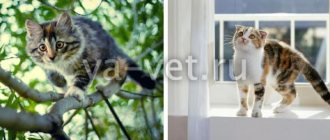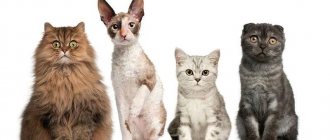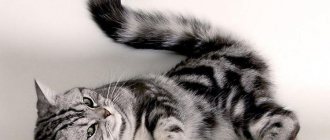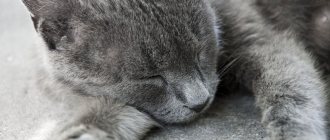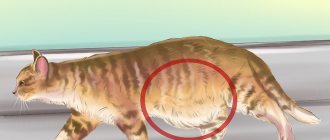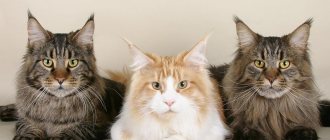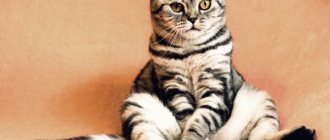Narrow pupils
If your pet's pupils suddenly and sharply constrict, this is a sign of extreme arousal. It can be caused by many reasons. You can understand the one that currently caused the effect by “additional indicators”, such as the position of the tail, ears, and body.
- Most often, constricted pupils show emotions such as anger and anger. The animal is in a bad mood. At the same time, the ears are tense and turned back. The mustache, on the contrary, is directed forward. The muscles are tense, the fur is raised. Often, the cat makes threatening sounds;
- but this is not the only reason. Constriction of the pupils can be caused, for example, by the smell of your favorite food or the appearance of another feline in the house;
- if the pupils are narrow, but the animal slightly closes its eyelids, purrs blissfully and lies calmly on your lap, it is blissful;
- Of course, we cannot fail to mention that bright light always leads to constriction of the pupils, and not only in cats.
How to understand what mood a cat is in
Cats may not be like people, but there is no getting away from the fact that they can experience a whole range of emotions that are very similar to humans. Read the Sputnik help on how to understand a cat’s mood: when he is angry, and when he is simply scared, and why he rubs against your legs and meows, although he has just eaten a hearty meal.
Tail hooked, ears erect: body language
Like their wild counterparts, cats spend most of the day sleeping. An awake cat, if it is well-fed and healthy, is actively interested in the world around it in search of potential prey or a playmate - even if it is home alone and it is just a rubber ball or a lace on your shoe.
© Sputnik Anastasia Kupriyanova
Cat life: how to notice that your pet is unwell
The cat's eyes sparkle, the tip of its tail trembles, it leans forward, comically putting the back of its body out? The cat wants to play and is about to rush forward! And he wiggles his butt in order to correct the balance and direction in the jump.
A raised tail with a quivering tip generally indicates that the cat is intrigued by a new object, smell, sound, and has not yet decided what to do next.
If the tail is raised like a “pipe” or even hangs over the ears, the cat is very happy. And if at the same time he rubs against your legs, arching his back, he’s happy for you. Or he just wants to eat.
If the tail is raised, the back is arched, but the ears are flattened, and the cat makes sounds that suggest an exorcist - the animal is irritated and, quite possibly, frightened. True, you will most likely find a truly scared cat somewhere under the sofa - cats are used to running away from danger at all costs. And only mother cats bravely attack an enemy even larger than them - there have been cases when angry wild cats put to flight wolves and bears that encroached on their offspring.
If a cat holds his tail in a rather vague position - somewhere at an angle of 45 degrees, this means that he is alarmed and has not yet decided how to react to what is happening.
© Pixabay
How to wash a cat so that neither he nor you get hurt
Anxiety may also be indicated by the fact that the cat “cuts” its ears - turns them in different directions, catching every sound.
But the alternating squeezing and unclenching of the paws is a reflex preserved from the cat’s childhood: with such movements the kitten “milks” the mother cat. It indicates maximum relaxation and a complacent mood - and how to deal with puffs on furniture and jeans, read Sputnik’s article on how to properly care for a cat’s claws.
What does a cat purr mean?
Cats can be very talkative, and their voices are very diverse. And if you listen and then correlate your pet’s behavior with the sounds it makes, your communication will move to a whole new level.
The most mysterious phenomenon, of course, remains the purring of a cat. Scientists are still arguing about the mechanism of this pleasant sound and what it is intended for, with a variety of versions put forward: from complete pacification to promoting the healing of wounds and even the treatment of cancer.
Be that as it may, it is correctly noted: most often a cat purrs when it feels good. The mother cat calms the kittens with her purring, telling them that everything is okay. Have you noticed how cats call their children? High-pitched sounds with an almost questioning intonation are the signal to which your pet reacts when you call him. True, if the cat wants to eat, he will come running to “hey there, come here,” and just the clinking of the bowl.
© Sputnik / Natalya Seliverstova
How to trim a cat's claws: cat manicure
Uternal grumbling and hissing are a warning; When attacking in earnest, cats often emit a piercing howl in order to scare the opponent. The screams and squeals of cats grappling under the windows are probably familiar to you. By the way, cats react nervously to someone else’s cry of pain: they can rush and try to “finish off” their fellow cat. Perhaps so that he does not give away his location to larger predators.
Some cats love to “talk” to their owners, responding to their words with their “meow”. Many people even try to communicate with their pet in their “language”, plunging the latter into bewilderment. But in reality, the sound itself, of course, does not carry any meaning - intonation is much more important.
Therefore, talk kindly to your cats, stroke them - and they will not remain indifferent to you.
Intense look
The cat may stare at you with wide eyes. And there may also be several reasons for this. Most often, in this way the animal asks to pay attention to it. It is hungry, wants affection, and feels bad. Or he wants to go to the toilet, but the tray is left behind the closed door.
With the help of a gaze, a cat can show its love. At the same time, she slowly closes her eyes. But an unfamiliar cat thus shows completely opposite emotions. She is trying to find out “who is boss” and the person, if he does not look away in time, may be attacked by an animal.
Also, the reason for a frozen gaze may be preparation for aggression. At the same time, the animal is tense, makes threatening sounds, and the tail moves from side to side.
And the most unusual reason for such a look may be the truly human pleasure we receive when, while relaxing, we look at how another person works. This is also sometimes characteristic of cats.
Cat body language
The cat arched her back and raised her tail - she was frightened by the situation, she was thinking about running away or staying for protection. When meeting other cats, this position can scare them and prevent a collision.
The cat rubs its head, butts, and moves its paws - a sign of a special predisposition towards the owner. If she allows herself to blink in the presence of her owner, sleeps next to him on her back, with her stomach exposed, her most vulnerable spot, then she trusts him infinitely.
The animal stares at a person or another cat with a frozen gaze, on alert - it waits and is ready to attack at the slightest threat.
The most correct answer to how to determine a cat’s mood can only be by combining all of the above symptoms. The cat is a very harmonious animal; it cannot react to what is happening only with its tail or movement of its head.
Dilated pupils
Most often, cats dilate their pupils when there is any danger. The ears are turned out and pressed down, the whiskers are directed back. Hissing and display of claws are often added.
The pupils dilate to the owner's call, while the ears extend in the direction of the sound. It is typical that the cat may not even turn towards the person, pretending that he does not hear him.
If the animal's eyes are wide open and its ears are alert, then it is most likely in a playful mood and the best way out would be to just play with it. And, naturally, cats' pupils dilate significantly in the dark.
To more accurately decipher a cat’s gaze, it is necessary to involve “witnesses”, such as ears, whiskers, body position, and sounds made by the animal. The most informative is the position and behavior of the tail. All this together will allow you to master the cat's language and always be aware of the emotional state of your pet.
Muzzle
Expressive cat eyes, whiskers and ears are capable of conveying the full range of feelings and emotions that the animal experiences. If the cat is at rest, its gaze also expresses attention and calmness. At the same time, the ears rise vertically, and the shell is turned forward. Wide eyes and alert ears indicate a playful mood. And if they are tense and turned back, while the whiskers stick out forward and the pupils are constricted, it means the cat is filled with anger, anger and dissatisfaction. When the eyes are half-closed and the muscles are relaxed, the cat experiences complete satisfaction and sympathy for the one who is next to her. But as soon as she opens her eyes wide, dilates her pupils, and presses her ears and mustache to her head, she can immediately recognize readiness to attack, aggression or fear.
What breeds of cats practically do not shed?
LiveInternetLiveInternet
Quote from Fyr's message
Read in full In your quotation book or community!
“PURRY” lifts your spirits.
Veronica writes
Animal-assisted therapy: will lift the mood of the “purr”
Animal-assisted therapy is a modern system of human treatment. Along with medications, the patient is recommended to communicate with animals. The fact that pets have a miraculous healing effect on their owners is a fact known since ancient times.
Pets not only relieve loneliness, but also benefit the health of their owners. That is why owners of cats and dogs live on average 5 years longer than those who do not have a four-legged friend. Cat purring is similar to acoustic vibration therapy in humans and may help slow osteoporosis and even promote bone growth in older people. Cats calm down and lower blood pressure. Their subtle biofield normalizes heart function, relieves tension and headaches, stimulates rapid healing of injuries and even treats internal inflammatory processes! The healing effect begins precisely when a person, stroking, caresses his pet, that is, through his fingers, palms. Cats are “prescribed” for hypertension, rheumatism, myocardial infarction, insomnia, stomach ulcers, gastritis, bronchitis, pneumonia, influenza, depression, neuroses, and nervous disorders. Cats brighten up loneliness, calm you down, and lower blood pressure. Their biofield stabilizes the functioning of the heart, relieves joint pain and headaches, stimulates the rapid healing of injuries, and treats internal inflammatory diseases. It is cats that have the amazing ability to lie down on the part of the body where the “breakdown” occurred. Your cat can sense when you're irritated or when you're about to have a heart attack. Her obsessive caresses warn: there is a malfunction in your energy system, it’s time to take medicine. Research by American scientists has found that the purring of domestic cats is not just a pleasant sound, but an effective method of treatment! Cats purr at a frequency between 22 and 44 hertz, and vibrations at this frequency speed up the process of cell regeneration. It is noteworthy that this frequency also improves the condition of human bone tissue. Therefore, communication with domestic cats really improves your health. Animal therapists believe that any animal that loves you has healing abilities. But the therapeutic properties are enhanced several times if the cat is an adult, healthy and friendly to people, sociable and balanced. By the way, there are cats that are especially gifted with this talent. Most often these are... black cats, which we usually avoid! They are the ones with the strongest energy. Scientific studies have been conducted on the topic of the healing abilities of cats that have shocked scientists. It has been found that petting a cat for a few minutes normalizes a person's blood pressure and reduces the risk of recurrent stroke and heart attack. The condition of the patients after the experiments was similar to the state of health after a session of meditation and relaxation. Our skin is directly connected through nerve receptors to the brain.
By petting a cat, we transmit signals to the brain through the skin of our fingers. We experience a feeling of relaxation and calm. When a cat or dog is caressed and the owner strokes its fur, this is nothing more than an electrostatic effect with weak currents. All physiotherapy today is based on the impact of weak currents on us. So a cat is essentially a home physiotherapy device. And traditional Eastern medicine is precisely based on the connection between the nervous system and individual areas of the body and skin. And everything in our body is subordinated to the nervous system. And through it you can indirectly influence internal organs. And this is already real reflexology. Long-haired cats (Persian, Angora, Burmese, Ragdoll, Siberian) are excellent neurologists. They can cope with any depression, insomnia and irritability. Persian cats are recognized as experts in the treatment of joint pain and osteochondrosis. Short-haired and hairless cats (Siamese, Oriental, Sphynx) help cope with diseases of the liver, kidneys, gastritis and colitis. Siamese cats also relieve colds: they somehow magically neutralize pathogenic microbes in the house. Medium-haired, “plush” breeds (British, exotic shorthair) are recognized as real specialists in heart diseases! It is known that cats are attracted to negative energy; they seem to absorb it. When any disturbances occur in our body or around us, it senses it and rushes to that place. The cat is designed in such a way that it needs this “recharging”. Each of us has observed how cats love to be near electrical appliances that emit negative electromagnetic waves. A person, on the contrary, in order to get rid of ailments, needs to remove negative energy. So, a cat is just a gift for him, a home healer. There are a couple more interesting facts related to the color of the animal: Black cats “take on” negative energy twice as much as other colors.
Cream cats tone up the owner’s energy. Red cats give off positive energy the most. Gray-blue cats calm, neutralize. White - in general, are considered medicinal according to all of the listed indicators. They even dull the feeling of hunger.
Holding a cat close to you by force will not produce a therapeutic effect. There must be a close relationship of trust between the owner and the cat. And if at the same time the cat starts purring and shows that she likes to be with you, the effect increases several times.
Animal World Post Series:
Part 1 - The Biggest Domestic Cats Part 2 - Today is Cat Day. Happy holiday! ... Part 32 - Cats are not like people Part 33 - 3 facts about cats that you didn’t know Part 34 - “PURRY” lifts your spirits.
Affection, friendliness
Since the cat is known as a proud, independent and vindictive creature, it is not easy to gain her trust. However, how do you know if you have succeeded?
There are several signs of affection and friendliness on the part of your family's furry pet:
- She sits on your lap and lightly kneads them with her claws.
- At night she only lies down next to you.
- During the day, the cat sits next to you or lies close to you.
- The cat lies on its back, showing off its belly, allowing you to pet it. This is a sign of special treatment on her part!
- She follows you around wherever you are. No, this is not a sign of her boredom or curiosity. Quite the contrary. The cat shows you its boundless love. She doesn't want to lie alone in a room when the owner is in another. So she gets up and follows you.
- Your pet shares the catch with you. However, this is mainly done by those who live outside the city.
The most harmful cat came to the shelter and she conquered the Internet with her quarrelsome character
Cats, like dogs, become very attached to their owner. Don’t forget about this and abuse the cat’s affection. Otherwise, she will simply be disappointed in you and regaining trust will not be so easy.
Curiosity
If following the owner's heels is not a sign of curiosity, then how does it manifest itself in cats?
A cat's curiosity is driven by survival in the wild. But thousands of years have passed since these cute animals were domesticated, but they continue to show their ingrained habits.
Apart from the fact that cats climb into places that either fit or not, at any noise or event that interests them, they become a “column,” that is, they sit on their hind legs and raise their front legs, just like gophers. Also, their eyes widen, their neck lengthens, and their ears rise and turn towards the source of the sound. This pose is very practical and convenient for exploring the environment.
The cat tracks your emotional state
The well-being of a cat largely depends on the emotional state of a person, which she knows very well. Therefore, even if you don't notice, your pet is constantly monitoring your mood. But it's not only that.
Some cats can truly become attached to their owner, especially if they live with him for a long time. For this reason, the animal is much more comfortable if the person is also comfortable. Such affection can be expressed in close attention: the cat waits for the person from work and does not leave him a single step when he returns home. For such pets it is really important what mood their owner is in.
Of course, not all cats are the same. Some of them depend more on the condition of the owner, some less. But all cats, without exception, perfectly understand the intentions of the person in front of them. Therefore, your pet will always feel whether you are aggressive or friendly towards it.
Fear
This is the most ancient emotion in living organisms, which has helped them survive for centuries. Your pet expresses her fear at a primitive level when she feels that her life is in some kind of danger, that is, the instinct of self-preservation is triggered.
Cat fear can be triggered by:
- by a person;
- other animals;
- a subject that, in her opinion, poses a threat not only real, but also imaginary.
Absolutely all representatives of the cat family react in three ways:
- They freeze, pressing into the ground and pressing their ears so that they cannot be seen.
- Attacks. Her muscles become tense, her fur stands up; she puffs up, and the cat itself arches its spine to look bigger and more dangerous, hisses, spits and growls. This is how they behave when they are driven into a corner or other trap.
- They run away. This is the most common way for cats to save their lives.
Some people scare cats for their own amusement. This is not recommended. First, you expose your pet to stress. He will remember this and will take revenge. So don’t be surprised if your cat then starts biting and scratching you for no reason. Secondly, this is fraught with consequences for her health: the cat will not feel safe and may get sick.
How to stop a cat from running around at night: 4 simple tips



